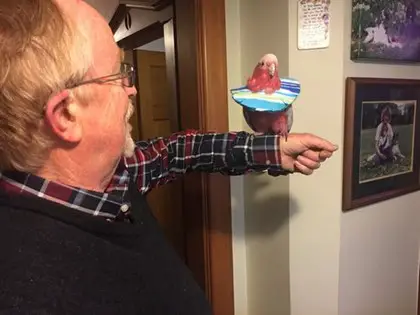In taking care of your bird, you can sometimes encounter some problems. One item that is commonly recommended by veterinarians is a bird collar. Bird collars are also known as restraint collars, e-collars, neck collars, and safety collars. These items are able to provide bird owners with a non-pharmaceutical method to prevent their birds from self-harm and self-injury. Here are more crucial bits of information about using a collar for your pet birds.
Why Your Pet Bird Needs A Bird Collar
Bird collars are efficient devices that you can use to prevent your feathered friend from bringing harm to themselves. These things follow after certain traumas, after undergoing surgeries, due to self-mutilation, and the habit of feather plucking.
Collars can be self-made from some fabric, or they can be bought from your trusted veterinarians and avian pet stores. They must be used in conjunction with an ongoing therapy treatment as well as manage the underlying problems they are managing. Bird collars serve as bandage solutions to help facilitate the bird’s healing, which will also help in keeping the bird to harm it even further.
Of course, the real medical problems that the bird is facing must still be diagnosed by a veterinarian as well as behavioral, surgical, and traumatic problems that must be addressed.
How to Choose A Bird Collar
- Choose a bird collar by style. – There are various styles of collars, and each of them has their own specific pros and cons. Each type of collar is suited to a specific type of personality, the intensity of plucking behavior, as well as your goals for providing a collar.
- Cone Bird Collars – Can help birds that have large patches of missing feathers
- T-Shield Collars – Perfect for dealing with surgical recovery and injury recovery
- Tube Collars – This can restrict the bird’s movement and can disrupt your bird’s daily activities
- Vests – Can help cover the bird’s back and chest by providing a comfortable swaddling nest
- Choose a bird collar depending on the location of the bird’s plucking. – Finding a collar that is perfect for your bird can take a few attempts of trial and error. But, your choice can depend on the exact spot that you are trying to protect. The patches that lack feathers can be towards the neck, the chest, the belly, or the back. It depends on that before making your final choice. Your options can be:
- Chest
- Under Wing
- Abdomen
- Feet and Legs
- Back
- Vent
- Neck
- Choose a bird collar depending on the severity of the bird’s plucking problem. – When purchasing from pet stores, you will be able to identify through this classification: mild, moderate, and severe. You should keep in mind that as the plucking problem progresses, the collar becomes more restrictive as well. This is because plucking is a very intense problem, and it can be an addictive behavior for your bird. This is why, before this disease worsens, you should rely on an intensified variety of strategies that can mitigate your problem. Your options are:
- Mild Feather Plucking
- Moderate Feather Plucking
- Sever Feather Pluckers
- Collars for Self-Mutilation
How to Determine the Severity of the Feather Plucking?
- Mild Feather Plucking
- This is distinguishable by a simple condition of tattered feathers.
- A bird that is hand-reared might not be able to be educated about how to preen and how to use their preening gland. They are always naturally clean and have realigned feathers throughout the day.
- If a bird has not been trained about preening, they might do themselves some damage.
- To manage this problem, bird owners must first consult with their avian veterinarian to examine if there is an underlying medical issue.
- Owners must also bathe their bird every day and get into the habit of rewarding good behavior.
- Moderate Feather Plucking
- This is distinguishable by seeing bald spots on a bird’s body.
- This occurs when plucking has turned into a habit. The birds might also have feather follicles that may become damaged, with further damage possibly introducing infection.
- To manage this problem, you should consult with your bird’s doctor first in order to rule out all possible medical concerns. There are different strategies to address this concern, which includes the application of a bird collar.
- You should also consider revisiting your current husbandry practices, routine modification, and environmental needs assessment.
- Severe Parrot Plucking
- This is exhibited when almost all of the feathers in the body have been plucked. This happens when these birds are actually addicted to plucking.
- To manage this intense problem, your bird must be given an extremely restrictive bird collar because this bird will do everything to destroy the feathers in their body.
- The bird owners must provide a heavy-duty bird collar that will restrict access to the favorite areas to pluck by your bird. Fabric collars won’t do enough. You should go for stiff and thick bird collars.
- You should plan on testing out a variety of bird collars and find the one that makes your bird comfortable by restricting their plucking access at the same time.
- Carefully assess if your bird will be able to handle their daily activities, so check out all the strategies for husbandry and remove all possible stressors.
- Self-Mutilation
- This happens when a bird seeps its damage in the muscle tissue and the skin.
- This habit usually begins when the bird picks out at one of its injuries, wounds, or scabs until it has dug a hole in its skin and muscle.
- Resolving this intensity can be an extremely long process, but this is not impossible to achieve.
Some Common Styles of Bird Collars
- T-Shield Bird Collar
- It is made from a clear and stiff plastic collar.
- It has a snap-on fastening system.
- It comes with a padded neck.
- Slip-On Style Bird Collar
- It is made from four layers of fleece.
- It provides a barrier between the beak of the bird and the back, chest, legs, and wings.
- To wear this, the owner must just have to slip this over the head of the birds.
- Velcro Closure Collar
- This is made from a fleece collar.
- This collar provides a thick barrier that is perfect for a more obsessive plucker and feather picker.
- This is also covered by 5 to 6 layers of thick fleece that is very hard to get off even for an insistent bird.
- It is also defended by extremely strong Velcro straps that are near impossible to rip off.
- Leather Bird Collar
- This collar is perfect for a bird that self-mutilates or is addicted to plucking.
- This is also a good match for birds who have just finished surgery.
- This usually comes with a 1.4 to 2 millimeters leather base partnered with an extremely secure Velcro fastening system.
- This type of bird collar is also topped with two layers of fleece for preening that can distract the bird from their own body.
Conclusion
Bird collars can definitely give support to your birds for their needs, but never forget to partner with your trusted veterinarian for a holistic approach for your bird’s overall health and wellness.


